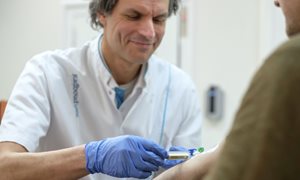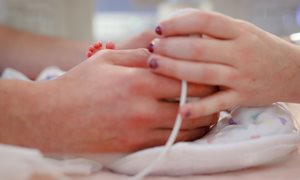
The vast majority of people are born with two working kidneys, but sometimes only one healthy kidney develops. The other is missing, or is not properly constructed. Radboud university medical center studies how a solitary functioning kidney arises and what the consequences are for patients.
Our kidneys filter the blood, removing waste products and producing urine. The kidneys each consist of a million tiny filters, which are only visible under a microscope. When a baby is born, the development of the kidneys is complete. With the filters people then have, they live for the rest of their life. Old age and, for example, being overweight, lead to wear and tear of these filters. And the fewer functioning filters, the harder the others have to work. So people born with one working kidney, only have half the number of filters. Those do work for two.
One kidney can't hurt - or can it?
In the Netherlands, fifty to eighty children are born with a solitary functioning kidney every year. For a long time it was thought that having one kidney can do no harm. In fact, each year an average of 500 people donate their kidney to a neighbor or stranger. They generally live on without complications. There was no reason to assume that this would be different for a congenital solitary functioning kidney. But PhD research by Michiel Schreuder, now Professor of Pediatric Nephrology at Radboud university medical center, showed that a solitary functioning kidney from birth does have major consequences in some people.
'This can't be true’
Michiel Schreuder: 'I studied the construction of kidney filters, and for this purpose examined a group of people with a congenital solitary functioning kidney. To our surprise we saw many patients with kidney damage. That one kidney works twice as hard, and thus wears out more quickly. In addition, the filters work less precisely. As a result, patients lose protein through the urine.' If a kidney works less than thirty percent, it is called kidney failure. This has major consequences, such as high blood pressure and fatigue. If the damage is too great, a kidney transplant or dialysis, in which the blood is filtered through a machine, come into the picture.
He had difficulty getting his work published. 'The prevailing opinion was really that one kidney does not give damage. Our results could not be right,' says Michiel Schreuder. But the publication came and brought about fundamental changes: young patients are now much better followed. A large group comes for check-ups in Radboudumc Amalia Children's Hospital. Schreuder: "Most children get through their childhood without any problems. But we want to know more about them. For research into the best treatment, we want to know who runs the risk of high blood pressure or kidney damage. At the moment we do not yet know how to distinguish between these groups of children. That is why we started our SOFIA study; with this we are trying to find out which children are at increased risk of having symptoms.'
All development during pregnancy
Researcher of the SOFIA study is PhD student Sander Groen in 't Woud. 'We want to find out the causes of a solitary functioning kidney, as well as map out the prognosis. Kidneys are already fully developed at birth, all they do is grow. You don't get any more kidney filters. So development during pregnancy is all-important. What mechanisms determine kidney development? Environmental factors or hereditary factors? And how do they relate to each other? We study both elements.'
Biobank for research into congenital disorders
For his research, Sander Groen in 't Woud scoured the entire country looking for children with a single kidney. He found almost a thousand of them. Their data is stored in the AGORA data and biobank at Radboud university medical center, coordinated by Groen in 't Woud and fellow researcher Loes van der Zanden. She explains: 'In AGORA biobank we collect data from children and adults with various congenital disorders, for example of the lip and palate or the heart. But the largest group is children with kidney or urinary tract disorders.
Looking for SNPs
Using saliva or blood from the children, the researchers are trying to gain more insight into the genetic cause of the solitary functioning kidney. In particular, they are focusing on Single Nucleotide Polymorphisms (SNPs). Every person has a unique DNA pattern, which can differ from someone else's DNA in numerous minute points, called SNPs.
Sander Groen in 't Woud: 'A single SNP increases the risk of a congenital solitary functioning kidney minimally at most, but a large number together can give a clearly increased risk. Detecting risk increasing SNPs in congenital disorders is difficult because the disorders are usually rare. We hope that our group of one thousand will be large enough to find these SNPs. In addition, relevant environmental factors are being sought using questionnaires for parents. 'Think of factors that may have influenced the unborn child during pregnancy, such as diseases and medication use,' says the PhD student.
A second kidney is more than spare capacity
There is still much research to be done around the solitary functioning kidney, such as finding out the relevant environmental factors and hereditary components. That is why Radboud university medical center, together with Michiel Schreuder, Loes van der Zanden and Sander Groen in 't Woud, plays a major role in the ArtDECO project, in which several teaching hospitals will jointly carry out more research into congenital kidney diseases. Radboud university medical center coordinates the collection of all data, for which the AGORA data and biobank has been extended to the other participating hospitals.
Michiel Schreuder wants to delay damage to the solitary functioning kidney as long as possible. A recent study shows hopeful results: 'One of our last animal studies showed that if we treat the kidney with medication already in the first weeks after birth, the wear and tear on the filters is delayed longer. We will investigate this further, but it is valuable information: tackling it quickly seems to have a positive effect on the functioning of the solitary functioning kidney.' So there is much more to learn, but one thing is certain: our second kidney means more than just spare capacity.
Different kidneys in identical twins?
Special research is underway on two identical twins, one child born with two normally functioning kidneys and the other with a solitary functioning kidney. Remarkable, because in identical twins both embryos arise from the same egg and sperm. Despite the same gene set, genetic differences sometimes arise after the two embryos have split. There can also be differences in the way the hereditary material is read (epigenetic difference). If such an (epi)genetic difference is in a gene that is crucial for kidney development, this might cause the solitary functioning kidney. Together with the Department of Genetics, researchers are now trying to find such genetic differences.
Photo: Sander Groen in 't Woud (left), Loes van der Zanden and Michiel Schreuder. Photograph: Paul Lagro.
-
Want to know more about these subjects? Click on the buttons below for more news.
More information
Pauline Dekhuijzen

wetenschaps- en persvoorlichter
Related news items






